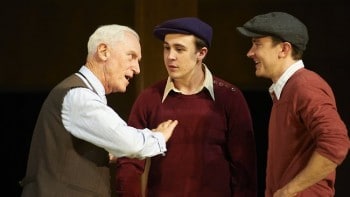Death of a Salesman – engaging and enchanting
After the first couple of scenes, it is obvious that you are about to settle into nearly two and a half hours of a predominantly dialogue-driven performance. For some, that might seem tedious. In this case of Arthur Miller’s American classic Death of a Salesman, the dialogue-heavy sequences are precisely what make it so powerfully engaging and enchanting.

Willy Loman is still a salesman at sixty-three; his son Biff is thirty-four. Despite looking like he had a promising football scholarship when he was seventeen, Biff has amounted to nothing. Living in the mid twentieth century, Willy is under financial stress and rapidly losing his hold on reality as his life appears to play out before him in all four corners of the stage.
John Stanton is nothing short of endearing as Willy Loman, getting into the mind of the character in a way that grips the hearts of the audience. The broken father-son relationship between Willy and Biff, brought to life by Josh McConville, is so electrically-charged that their exchanges drive the play forward at an alarming pace. Precision and detail was evident in the performances of these men down to their accents, a credit to themselves and dialect coach, James Hagan.
Another highlight was Caroline McKenzie as Willy’s devoted, resilient wife Linda. Her presence on stage is phenomenal. Even when silent, she is a strong figure. Ben O’Toole and Eden Falk also made notable performances as optimistic brother, Happy and brainy neighbour, Bernard respectively. As an ensemble, the cast is outstanding, directed purposefully by Adam Mitchell to effectively execute the overlapping timelines.
Due to the strong focus on dialogue, every technical element was appropriately subtle, complementing the performance in a way delicate enough to add depth, but not enough to overwhelm the strongest points. The lighting (Trent Suidgeest) and sound (Ben Collins) were predominantly used as internal devices, indicating time of day and telephone calls.
At the beginning of the play, it was the set design (Alicia Clements) that made the first impression. Almost a character of its own, the enormous, minimalistic room sweeps over the audience and creates a spacious, empty atmosphere. From the start the set, coupled with the costume design (Lynn Ferguson), immerses the audience and draws them into the world of the performance.
Regardless of life experience, just about anyone will be able to relate to Death of a Salesman. It is timeless, just as relevant in a contemporary world in terms of financial stress and the struggles associated with aging. No family is perfect, and very few father-son relationships are without their speed bumps, and this charming classic from Arthur Miller knows this so well.
Bookings: www.bsstc.com.au
